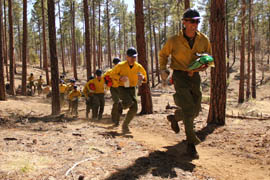TOP: Members of the Granite Mountain Hotshots run during training on the use of emergency fire shelters. (Cronkite News Service photo by Connor Radnovich)
BOTTOM: Phillip Maldonado, a squad leader with the Granite Mountain Hotshots, helps crew member learn the finer points of setting up emergency fire shelters. Training is key as the crew prepares for what’s expected to be a busy wildfire season. (Cronkite News Service photo by Connor Radnovich)
Eds: This story was originally published April 25, 2012.
By CONNOR RADNOVICH Cronkite News Service
PRESCOTT – “Fire everywhere!”
Phillip “Mando” Maldonado, a squad leader, shouts instructions as a dozen hotshots, firefighters trained to combat wildfires in extreme conditions, face a nightmare scenario: flames rushing in from all sides and their survival hinging on successfully unfolding and wrapping themselves in thin sheets of heat-reflecting material.
“Get down! Heads toward center!” Maldonado yells, the urgency in his voice rising.
Diving to the ground, crew members attempt to form a tight circle and point their feet toward the approaching flames. That will deflect heat and help protect their torsos.
They clamp down on the edges of their emergency shelters to make sure fire, smoke and heat can’t get inside, and they keep their faces near the ground to breathe cooler air that won’t damage their lungs.
There’s nothing to do now but wait.
Walking among the shelters several minutes later, Maldonado and another squad leader, Clayton Whitted, see that first-year hotshot Shane Arollado has made a fatal mistake: His head pointed toward the approaching fire.
Suddenly the survivors ask playfully if Arollado’s girlfriend is now available.
“Like hell!” Arollado shouts.
Members of the Granite Mountain Hotshots, one of 112 Interagency Hotshot Crews around the country, have never had to use shelters during a wildfire. But working in remote locations to get ahead of the most dangerous sections of fires makes knowing how to do so a matter of life and death.
Training is crucial, especially for the four rookies on the 22-member squad.
“If we’re not actually doing it, we’re thinking and planning about it,” said Eric Marsh, superintendent of the Granite Mountain Hotshots.
“When we get out there, it’s a completely different ballgame,” said Daniel McCarty, another squad leader. “It’s the real deal. We have to look out for each other.”
The crew, one of 13 hotshot teams in Arizona, has eight full-time members. The rest work from April until September.
Brady Higgs, in his second year with the crew, said the camaraderie and opportunity to travel drew him to this job.
“I couldn’t work inside, I don’t think,” Higgs said. “I enjoy the work, I enjoy getting to go outside and see the country.”
Being on a hotshot crew means one is on call throughout fire season, staying close enough to head out on short notice.
Fire duty can mean staying in the forest rather than returning to base camp for the night. Members of the Granite Mountain Hotshots sometimes have to spend up to two straight weeks in the wilderness, getting supplies by helicopter.
“These guys kinda become my family,” said Maldonado, the squad leader. “I saw them more than I saw my girlfriend last year.”
Last year, the Granite Mountain Hotshots fought some of the biggest fires in Arizona — Wallow, Horseshoe Two and Monument – as well as blazes in states such as Colorado, New Mexico and Minnesota.
Having to operate in the wilderness with little support, training is a way of life. On a recent weekday, preparing for fire season, members of the Granite Mountain Hotshots practiced setting up fire shelters as well as cutting fire lines.
The day included watching a video on how to use emergency shelters and what conditions crew members might face if overrun by fire.
The video featured survivors of the 1990 Dude Fire near Payson, in which six firefighters died despite wrapping themselves in shelters.
For training, crew members used green tarps shaped and packaged like fire shelters. Once the hotshots got inside, other crew members yanked on the tarps to simulate the high winds they could face.
After running the exercise once, they did it again.
When Arollado “died” during both run-throughs – it was his first time using a shelter – squad leaders Maldonado and Whitted pulled him aside to give tips.
“They were really great at showing me where I went wrong,” Arollado said. “There’s always someone trying to point you in the right direction.”
The crew also dug 1,000 feet of 3-foot-wide fire line, with some hotshots wielding chainsaws to cut down down trees and bushes.
Marsh, the crew’s superintendent, said later that everyone was rusty with training just under way. It’s particularly difficult for rookies who only have classroom experience, he said.
“It’s not uncommon to have a rookie die,” Marsh said. “Fake die, of course.”
But better to have mistakes happen here, where training can correct them, than in a real fire.
“In any other job you don’t have to worry about your life day in and day out,” said McCarty, the squad leader. “But in this job you have to watch your buddy too.”
Hotshot facts:
• The name “hotshot” comes from the hottest part of the fire, the place where these crews usually work.
• Crews can be sent across the country, often hiking or taking a helicopter into rugged terrain.
• Crews are required to remain on call during fire season, which can last up around six months.
• Because of their demanding jobs, hotshots are required to maintain a high fitness level.
• Interagency Hotshot Crews (IHC), the umbrella organization for hotshot crews, was created in the early 1980s.
Source: U.S. Forest Service










No comments:
Post a Comment